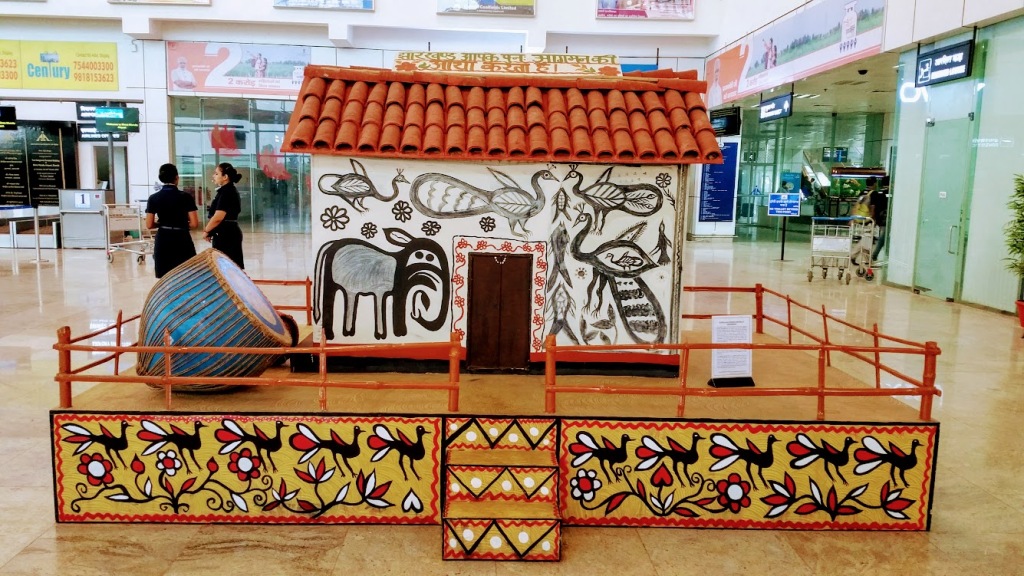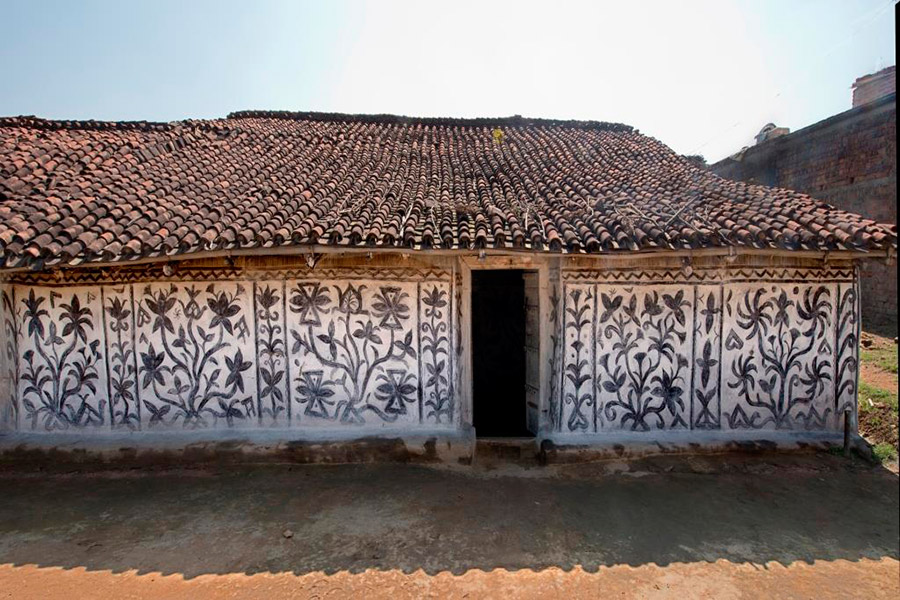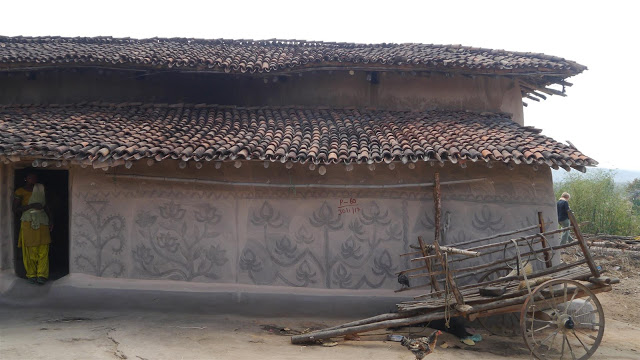I was traveling to Delhi from Birsa Munda airport in Ranchi. As I entered the check-in area at the arrival terminal, I saw a bright replica of an Adivasi hut with sohrai and khovar wall painting.

Khovar art is a traditional mural painting that is used to decorate the nuptial chambers of the bride and groom in the Hazaribagh region of Jharkhand, India. It is one of the two historical mural-painting traditions of the region, along with Sohrai art, which is related to the harvest festival. Khovar art is practised by several indigenous and artisan communities, such as the Santhal, Munda, Oraon, Agaria, Kurmi, Ghatwal, Ganju and Prajapati. These paintings are considered to bring good luck.
The word Khovar comes from kho, which means chamber or cave, and var, which means a married couple. The origin of Khovar art can be traced back to the rock art found in the rock shelters of Isko and Satpahar Range, which date back to the meso-chalcolithic period (approximately 7000–4000 BCE). The rock shelters are also known as khovar and are believed to be ancient nuptial chambers. The motifs and animal patterns in the rock art are similar to those in the mural art.

Khovar art is done by women of the bride’s family, who prepare the wedding room by applying different layers of clay on the walls. The first layer is a dark clay that symbolises the womb, and the second layer is a white or cream-coloured clay that symbolises sperm. While the second layer is still wet, the women use pieces of comb or their fingers to scrape off the clay and create paintings. The paintings depict fertility and male-female relationships, and feature animals such as elephants, turtles, peacocks and lotuses. The paintings are dedicated to Pashupati, the ruler of creatures.
The personal experiences of the artists and their interactions with nature are the biggest influence in these art forms. Forest-dwelling tribes shave forest forms into their artworks, sketching the tiger, deer, elephant, peacock, and snake. River-valley and plains-dwelling agricultural tribes shave domestic animal forms like the cow, bull, goat, fowl, pigeon, peacock and lotus.

The marriage season runs from January until the onset of the monsoons in June. It is in these months that Khovar designs are painted by the mother of the bride and other women of the villages as part of their traditional matrimonial ritual, where the marriage rites are performed, and the newlywed couple will sleep. This special area of the house is painted and decorated. Mothers pass on to daughters down countless generations the skills and motifs to create murals.

This technique of comb cutting is similar to the “Sgraffito” technique of Greece and the incised pottery technique found in Iran and the Indus valley. With the increasing effects of urbanisation, and the reluctance of the younger generation to continue with their traditions, there are only a handful of villages left where people still paint their houses.
Khovar art is a unique and rich cultural heritage that reflects the matriarchal roots and natural connection of the communities that practise it. It is also a living tradition that has adapted to changing times and mediums. Nowadays, Khovar paintings are also done on paper and cloth so that they can be sold to patrons.
Post Script
Jharkhand’s Sohrai-Khovar painting was given the Geographical Indication (GI) tag by the Geographical Indications Registry headquartered in Chennai.

Reblogged this on Things I’ve read or intend to .
LikeLike
Wonderful article; was not aware of this beautiful art form.
Thanks for sharing!
LikeLiked by 1 person
Thanks Rashmi for your like.
LikeLike
It is beautifully neat.
LikeLiked by 1 person
Thanks, Puja.
LikeLiked by 1 person
Welcome 😊
LikeLiked by 1 person
It is so beautiful and so interesting to learn about this. Thank you for sharing. It is indeed sad that traditional and ancient arts being ignored today.
LikeLiked by 1 person
Yes, the modernisation and urbanisation is slowly killing the ancient, traditional arts everywhere. Jharkhand government is trying to promote these art forms by getting the city walls painted by Sohrai and Khovar artists. This is serving both the purpose of beautification as well as promotion of indigenous art forms.
LikeLiked by 1 person
Looks great
LikeLiked by 1 person
I like your post 😊.
LikeLiked by 1 person
Thanks Loshame. 🙂
LikeLiked by 1 person
😉
LikeLiked by 1 person
Wow I didn’t noticed these in My own hometown …😎
LikeLiked by 1 person
This is so interesting! I love hearing about other places and other cultures.
LikeLiked by 1 person
Thanks, Georgia.
LikeLike
Thanks for sharing the post on this beautiful form of tribal art. Hope such art forms are supported and preserved.
LikeLiked by 1 person
Thanks Somali. I agree with you that such art forms are supported and preserved.
LikeLike
Hi,
This article is very informative. Great piece of work. My name is Kislay Komal and I have spent 10 years in Jharkhand while doing my schooling from Jamshedpur. Now i am promoting traditional arts and wanted to get connected with the artists of these arts. In case you can help. I put them on global map through my initiative http://www.artsofindia.in. I can be reached on 9880027443.
Thanks
Kislay
LikeLiked by 1 person
Wow! Nice art. Amazing skill with these tribal womenfolk.
LikeLiked by 1 person
Pingback: 10 Indian Tribal Art Forms For Beginners - India Chalk
Pingback: Ancient Varli Art: A Glimpse into the Rich Cultural Heritage of India – Indrosphere
Absolutely gorgeous. Thank you for sharing.
LikeLiked by 1 person
Thanks, Leah
LikeLiked by 1 person